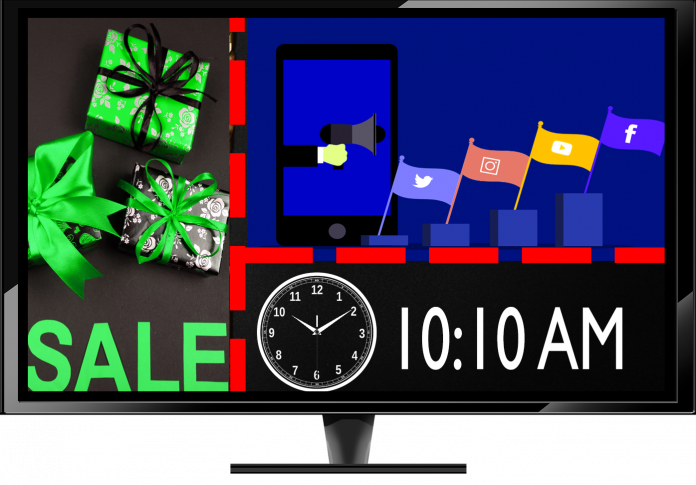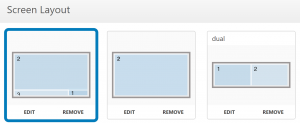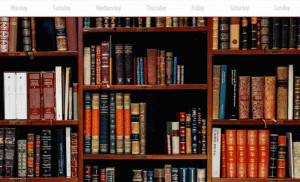If you’re an OnSign TV user, or a digital signage software user in general, you need to know which tools are available to you and—most importantly—which tools you’re missing out on! In this article, we’ll briefly go over the features of digital signage software that can launch your digital signage to success and how to use them for maximum potential. Let’s dive right in!
Campaigns
Campaigns are easily the most important bit as they let you split the screen into several parts and showcase multiple streams of content at once. You know this already, but are you using campaigns to their full potential? Keep in mind the environment of each campaign, and consider what the viewer will want to see. In a lounge environment, include your main content on the larger part of the screen, and dedicate other parts to social media posts, promotional offers, time, weather, news, etc.
They’re best for splitting the screen, but campaigns are also an excellent testing ground. If you want to dip your toes into using testimonials, or social media to see how receptive your audience is, include such content in the corner of the display. You’re not sacrificing your main content for testing purposes, but you’ll still see if there is enough engagement to give you the green light to push for more.
Reports
Bureaucracy and raw data are surely not the most thrilling part of digital signage, but they are of high value if you want to be successful. In short, reports paint a clear picture of what transpired on your displays. This includes information on which content was successfully displayed, as well as where and for how long it streamed.
Analytics
Reports are invaluable for continuous improvement of your content. Cross-referencing report data with analytics and data on your sales will tell you which content was successful at impacting the viewer.
If you see a spike in your Twitter followers after displaying your Twitter handle on your lobby displays, you’ll know that it works. So keep doing it! On the other hand, if you spend a considerable amount of cash to produce a 30-second video ad and see no change in sales over the time the ad was active, you’ll learn that your campaign failed. Maybe it was too long? Maybe dull? Cheesy? It missed the mark, that’s what matters. But at least you know and each subsequent campaign will be stronger than the last.
Proof of success
Reports are a great way to check in on your digital signage if your staff is managing it, or if you’re hiring a third party to handle it. A monthly report will give you an insight into how much content was displayed, for how long, and how diverse the content was.
Reports are also an excellent tool when looking to sell your advertising space. They act as physical proof to bring clients on board and present data clearly. Once you get clients on board, delivering monthly reports to them is a clean and professional way to confirm the campaign was active for the agreed duration. Your clients will know that they’re getting what they paid for.
Content scheduling
Scheduling content is a fairly straightforward feature. While utterly simple, it’s so powerful. Don’t just think in weekly terms. Take scheduling further to extract the most use out of it. You can strategically loop content in a way to not become stale or repetitive. Let’s presume your business has a lobby. Ideally, you don’t want the people waiting there to see the same video ad multiple times within their wait time. Get strategic about time management! If the average wait time is 5 minutes, get the ad to play once, maybe twice, within this time frame.
Digging deeper, are the people waiting in the lobby returning customers? People might go to the same bakery daily, for example. If so, mix up the content and have it repeat every other day, or every other week. You can even start working on your Christmas campaigns today! Just schedule them for December when you’re done.
Clever content scheduling takes time, and it really depends on your customer base, how often they visit, how long they stay, and what mental state they’re in. The beauty of scheduling content with digital signage software is that it’s easy to replace outdated content while maintaining the complex schedule you built.
Testimonials
We won’t go into the power of testimonials and how to structure them, as that’s a long story on its own. What is important to note, however, is that digital signage can quickly make use of testimonials you receive from your consumers.
Something as simple as a social media post can be a great addition to your content rotation. A subtle way is to dedicate a small portion of the display for this. Or, where appropriate, dedicate an entire display solely to testimonials.
Apps
Apps are simply a must. Basically, if you’re not using apps, you’re wasting time and opportunity. There’s little to be gained in doing things manually when you have tools to do it for you.
Some apps are great for entertainment or making your digital signage more relevant and interesting such as apps for time, weather, news, RSS feeds, inspirational quotes, as well as daily fun facts. Other apps you’ll find are more business focused and will help you quickly feature a promotional product, push a sale, or pop up a menu in a jiffy.
App variety
Don’t let app names or examples convince you that you can’t use them. They’re very versatile and you can adapt most, if not all, to serve your scope. Take a look at the Cafeteria App, the latest addition to OnSign TV. It shows which menu items are available on each day of the week. Quite simple, right? But while it’s ideal for a cafeteria environment, it’s just as usable in many other contexts! A clinic or a university can display which departments and staff members are available for consulting. A gym or a yoga studio can showcase programs available on each day of the week.
If your business uses a menu of any sort, or changes its offers on a weekly, daily, or even hourly basis, the Cafeteria App will be an important tool you’ll want to use! Other apps are similar in their versatility. Their names are merely examples, but they are built to be usable in as many contexts as possible.
No app is restricted to a specific business type. Get creative and adapt the apps to serve you. Take a look at these restaurant apps and find ways to incorporate them in your own business. In the meantime, stay tuned for more guidelines like these in the future, so we can brainstorm together on how to best use digital signage software for your business.









